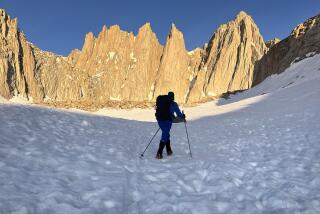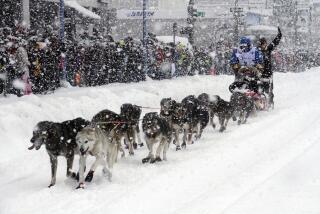Last Word on Dog-Sledding in Alaska: ‘Whoa!’
- Share via
FAIRBANKS, Alaska — We were coasting along at about eight miles an hour: The only sounds were the swoosh of the runners, the rush of the frosty air and occasional barks or bays from 10 excited huskies. Steve Howdershell, the musher, directed me to look to the left at the fresh prints of a fox in the drifted snow, then over to my right, where two moose had recently lumbered among the naked willow trees.
Howdershell stood behind me on the runners of the sled. It was 15 degrees below zero. I was cocooned inside a snowsuit, down parka and Army-issue mukluks, my entire body zipped inside a brown canvas covering designed to keep the sled’s cargo intact: I was the cargo. Bundled up in my woolen headscarf, watch cap and the hood of my parka, with my muffler pulled up over my nose and mouth, I had trouble projecting my comments to Howdershell as I expressed my appreciation of the scenery and the ride.
Then he asked me if I wanted to drive.
A healthy-looking former construction worker in his mid-30s, Howdershell plunked himself down on the sled, his rabbit fur-booted legs stretched out in front of him and his massive light brown beard covered with frost. I stood on the brake, a horizontal metal bar, at the back of the sled. “If you fall off,” the musher warned, “just hang on and let the sled drag you.”
This prospect did not at all appeal to me, so I gritted my teeth and determined to keep my balance at all cost. Then, without asking if I was ready, Howdershell shouted “Hike!” as if a football game were about to begin. I was still standing on the brake, but the 10 dogs, barking merrily, started down the trail anyway. I leaped up and landed with one mukluk on each runner of the sled.
You might well ask what I was doing in Fairbanks, Alaska, in the dead middle of winter last year. I really can offer no good excuse. In addition to visiting old friends, I simply wanted to see Alaska again in a season in which I’d never seen it before, to experience some of the coldest weather the Earth has to offer.
During my week-and-a-half-long visit in February, I had taken a sauna and rolled (briefly!) in the snow, fulfilling a lifetime ambition. But I was hoping to arrange a dog-sledding trip before I departed. Unfortunately, it seemed that all my friends’ acquaintances who ran dogs weren’t available.
Then we heard about Steve Howdershell. He is the official musher at Old F.E. Co. Gold Camp, a funky Old West-style resort at Chatanika, about 20 minutes north of Fairbanks by car. The gold camp--which has been in continuous operation since 1923, when it really was a gold camp--offers one of the few opportunities for just plain folks to have a dog-sledding adventure, short of hiring a guide and heading off into the bush.
Howdershell offers rides ranging from 15 minutes to “as long as you want to go” at prices starting at $20 per person. The resort proprietors, Larry and Pam McLaughlin, have recently finished building an elaborate “Auroreum” for comfortable indoor viewing of Northern Lights. They told me Chatanika is a great favorite of Japanese tourists, who apparently flock to Alaska in droves (the resort’s flyers are printed in English and Japanese).
As I was the first fare of the day (and, as it turned out, the only fare), I was allowed to help harness the dogs.
I had just seen the movie “White Fang” and was in the process of reading Natalie Kusz’s “Road Song,” an extraordinary memoir of her disfigurement as a child by a hungry sled dog, so it was not without a little trepidation that I walked down into the snowy yard filled with some 40 barking huskies. I’d assumed that this business of “helping” was just a sop for tourists. But indeed I had a real job to do and it wasn’t altogether easy.
Howdershell laid out the trap line--about 20 feet long--and then circulated among the howling huskies to find Boomer, the lead dog. Holding the dog by the scruff of his neck like a kitten, Howdershell slipped a harness over Boomer, attached him to the main line and told me to hold him there. Fortunately, Boomer seemed to be extremely friendly. He was followed by Minnie, the lead-dog-in-training, who was hooked up by his side.
The harnessing process was a long one for the eight dogs who followed Minnie and Boomer: There were Daisy and Chewy, the so-called “swing dogs,” Shadow, Caspar, Hooker and Harley, the “team dogs,” and Butch and Bruno, the largest, who were the “wheel dogs.”
Mushers use the same commands as mule drivers: “Gee!” means “Turn to the right,” “Haw!” means turn left, “Whoa!” for stop and “Hike!” for go. To my enormous relief, even after he put me in the driver’s position, Howdershell was the one who shouted all instructions to his dogs as we flew along the trail. From the back of the sled I had a greater sensation of speed. It was very much like skiing--well, perhaps like skiing and pushing a shopping cart at the same time. My face and hands were positively hot with excitement.
“I never take tourists out when the weather drops below 30,” he said. That’s 30 below zero. “But I run the dogs myself down to 70.” Mushers, who are solicitous of their dogs’ well-being, put little cloth booties on their animals when the weather falls below minus 20, when the dogs are tired or when trail conditions warrant.
Mushing is to, say, riding on a snowmobile as sailing is to driving a motorboat. There’s no sound but the wind, the snow, the dogs. I could feel each undulation of the trail beneath my boots.
I had arranged to go out for a 20-minute ride. When we flew down the last hill and the camp came into sight, Howdershell called “Whoa!” to the dogs and told me to stomp down on the brake. I did, but my weight wasn’t enough to even slow us down. There are little metal hooks on the brake (called, rather confusingly, dogs ) that are supposed to dig down into the snow and stop the sled. Apparently I didn’t cause them to dig down far enough. Howdershell continued to bellow “Whoa, dogs, whoa!” as we swirled on past the gold camp and the parking lot, onto the harder snow that had been packed down by trucks and cars. My braking was even more ineffective then, and we built up speed. Off we flew into the woods again. As we reached softer, deeper snow, the dogs eventually lost interest in racing and we stopped.
There’s no way to simply turn a team of sled dogs around on a narrow trail and go back the way you came. “We’ll come to a loop about a mile from here,” Howdershell told me, grinning like Father Christmas through his icy beard. “But I think I’ll drive this time.”
The trail here was less used and I had to dodge my head several times to avoid the low branches and bits of snow flung off them as the dogs raced by. “Keep your arms in on this one,” the musher warned as we rounded a corner, toboggan-style, at a 45-degree angle. He needn’t have reminded me--my hands were balled into fists inside my ski gloves for greater warmth and tucked down inside the canvas cocoon.
The last of the ride was bumpy and fast. The 3 o’clock sky was stained a pale wash of orange on the horizon past the silhouetted birch trees, spruce and willows.
After my ride (10 minutes extra at no extra charge), over a steaming cup of hot chocolate, I had a sudden realization. “Excuse me,” I said to Howdershell, who was pulling off his gloves. “But it just occurred to me that you never once said, ‘Mush, you huskies, mush!”’
He wiped his sleeve across his dripping beard. “The last person to say that,” he said with a smile, “was Sgt. Preston of the Yukon.”
I guess it wouldn’t mean much to the Japanese tourists, anyway.
GUIDEBOOK
Alaska Dog-Sledding
Getting there: Alaska Airlines has daily flights from all Los Angeles-area airports to Fairbanks through Seattle and Anchorage. With 21-day advance booking and midweek departure, the round-trip fare is $490 ($50 more from Orange County and Ontario).
Where to stay: Fairbanks has 18 hotels that offer accommodations year-round, including several luxurious hotels downtown. Outside town, the Chena Hot Springs Resort offers a beautiful woodland setting, steaming mineral pools and cabins with kitchens. For reservations: 110 FCVB Antoinette Ave., Fairbanks, Alaska 99701, (907) 452-7867. The Old F.E. Co. Gold Camp in Chatanika has antique-filled bedrooms and shared bathrooms. Doubles are $45.50 (singles $4 less), suites to $62.50. Write P.O. Box 72537, Fairbanks, 99007, (907) 389-2414.
What to wear: In January, the weather in Fairbanks has been known to range from 45 degrees above zero to 45 degrees below. Take plenty long underwear, lots of down and layers of clothing. Scandinavian felt boots seem to work best at the really low temperatures. Make sure that your feet have lots of room: a borrowed pair of canvas, Army-issue mukluks that were about two sizes too large kept me toastier than a pair of closer-fitting--and very expensive--snow boots. Mittens keep your hands warmer than gloves.
Winter recreation: Alaska is a cross-country skier’s paradise, and you can downhill ski at Cleary Summit Ski Lodge or Skiland, both on the Steese Highway on the way to Chatanika. Dog-sledding is available at the Chatanika Gold Camp from November through April. Steve Howdershell, the musher, also leads fishing trips in the summertime. Contact Wildertrek Alaska, P.O. Box 16207, Two Rivers 99716, (907) 488-7231. Another dog-sledding source is the Alaska Dog Mushers Assn., (907) 457-MUSH. You can also try ice fishing, ride in a sleigh or snowmobile, or watch one of the many sled-dog races that begin and end in Fairbanks, including the Yukon Quest on Feb. 9.
For more information: Contact the Fairbanks Convention and Visitors Bureau, 550 First Ave., Fairbanks, Alaska 99701, (800) 327-5774 or (907) 456-5774.
More to Read
Sign up for The Wild
We’ll help you find the best places to hike, bike and run, as well as the perfect silent spots for meditation and yoga.
You may occasionally receive promotional content from the Los Angeles Times.






